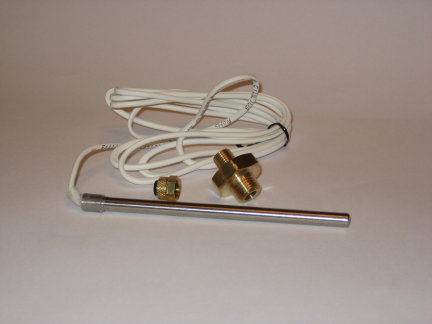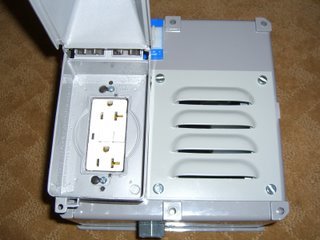p4ck37p1mp
Well-Known Member
I just found out I get mine Thursday or Friday, so expect another thread to get started! 

Can the control cable to the temp probe be removed to remove the keggles for washing without wash water damaging the temp probe terminals and socket end?
I just found out I get mine Thursday or Friday, so expect another thread to get started!
Yeah, the temperature probes have a nice little compression fitting that goes around the temperature probe and is finger tightened(or a little bit more)...that comes right off, probe slides out and you can manipulate the keggle freely at that point. And it goes back in just as easy and is water tight without any messing around with teflon tape.
Yeah, the temperature probes have a nice little compression fitting that goes around the temperature probe and is finger tightened(or a little bit more)...that comes right off, probe slides out and you can manipulate the keggle freely at that point. And it goes back in just as easy and is water tight without any messing around with teflon tape.
That means you must loosen the compression nut which compresses the rubber or soft compressable washer around the probe then remove the probe and cable feeding it before removing and cleaning the keggles everytime at the end of a brewing session. What a PITA to replace the probe with a rod of the same diameter to prevent a leak you just created by removing the temp probe hanging by the cable that's dangling while you remove the keggle to properly clean it after every use. A new system put on the market fast as possible with good features but not 100% simple friendly to use or complete and functional unless it must be disassembled every time. This will get old quick.
Was this a quick race to market for fast profits vs any added delays to correct and build a completely clean and simple to use system? Sorry I smell money as the priority here. Months ago I stated take your time on this project and make it right. This means to remove the kettles for cleaning everytime is to remove the temp probe cable then adding a Trojan with rubber band on the temp probe connection? Sounds like there is no waterproof cap available to protect the probe terminals not alone the threads from mechanical damge as brass threads are easy to damage. Just had to comment my disappointment to what started out as a great idea that's gone to market too fast. JMO's not to start a flame war.

Was this a quick race to market for fast profits vs any added delays to correct and build a completely clean and simple to use system? Sorry I smell money as the priority here.
Pictures please! I've been trying to figure out how I'm going to rig my system once I get the bcs. I could use any help you all offer.
Could you program a 5 day ferment at say 50 degrees, 1 day at 60 for a diacetyl rest, then go to 32 to lager without having the laptop connected?
Linc
The reason that I chose these probes is that you don't need a thermowell. They can be immersed in hot/boiling wort directly with an easy leakfree connection.
That being said, there is nothing stopping you from using a thermowell. The probes are 1/4" in diameter, not coincidentally the same as the standard thermowell inside diameter. With the thermowell installed on your system, you could remove the probe for cleaning without fear of a leaking void.
The probe housing is very rugged 304 Stainless Steel. As previously mentioned, it comes with a Brass bulkhead and compression sleeve. If you don't like Brass, please just think of the bulkhead as a nice free paperweight. Each system/brewer is different, so it would be impossible to offer every imaginable probe connection option.
Cheers!
Adam

Thanks for the photo that clears up my idea about NOT removing the cable to the probe besides the RTD idea.
In the probe lead is that a two conductor with a grounding shield wrapped around the outside of the conductors and if so is it grounded at the 460 unit?
I'm thinking for my use to cut the probe cable close to the probe then using Radio Control model gold plated connectors in the right conductor count allowing for simple removal of the keggles for transporting, storage or cleaning of the brewing system. Silicone seal the cable entering the probe as well the cable cover, grounding shield and wires inside at the cut end behind the connector making for a waterproof probe as well.
No, the wire is fairly standard two wire with no shielding. It is not required anyway, as the Mash tun is grounded. However to answer your next question, a much simpler and cheaper way to get portable with the probe would be to get yourself a set of bayonet type connecters, they have been used in the industry for years. I know they are old tech, but they must work, because even Fluke still uses them for their temp sensor hook ups on their high end testing equipment . Anyway just a suggestion. S.

Any idea how much they cost?Float switches are probably the most economical. And easy to interface to the BCS-460 - connect one wire to +5V, and the other to a Din. So if Din=On, the switch is closed, Off = open.
Another option that I just ran across on the web:
Check these out:

http://sensing.honeywell.com/index.cfm/ci_id/140802/la_id/1/document/1/re_id/0
These sensors look very cool, and easy to interface to the BCS. But they're a little pricey. They work by using an internal LED, and when the no liquid is present all of the light is reflected back. When liquid covers the dome, some light escapes, and the sensor sends a 5V on/off back to the controller. I wonder what it does in the presence of foam (or splashes). Anyone use anything like this before?
Also, how are you guys dealing with your SSRs and power outlets in terms of water proofing? I looked at some outdoor NEMA enclosures to house the SSRs and the BCS itself.


BCS may live where my network gear goes and I'll run some cat5 to carry probe and other connections.
I also like the idea of the plastic sensor. But on the page is says it contains lead? I don't know if that's something to be concerned about or not (will it leach into the mash?).How high temp is that plastic one? I didn't see anything on that page as to max temp. I like the idea of that better than a float switch, and that price is not much more than a good float switch. Also, how are you guys dealing with your SSRs and power outlets in terms of water proofing? I looked at some outdoor NEMA enclosures to house the SSRs and the BCS itself. Not sure how I want to do my power outlets, other than using GFI. I may cut the plugs off the pumps and just hard wire them to the SSRs. BCS may live where my network gear goes and I'll run some cat5 to carry probe and other connections. Anyone have any thoughts or advice?

The datasheet says the high temp ones are good up to 257degF. It doesn't say what type of material, only Plastic. But under typical applications, it lists Food and Beverage, and Medical.How high temp is that plastic one?
Enter your email address to join: